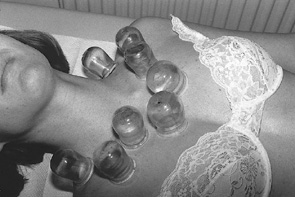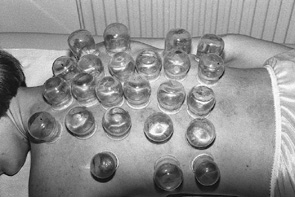Respiratory Tracts
Bronchial Asthma
Bronchial asthma has different causes. It can arise following influenza or pneumonia or in chronic disease of the throat and nose. In addition to chronic catarrhs of the airways, hypersensitivity (allergic reaction) is a key factor in asthma. Psychological or nervous causes (psychological tension or stress, fear, fright, etc.) are also significant. Climate and weather conditions, lastly, have a triggering and boosting effect.
Regardless of the mechanism by which it formed, episodes manifest in shortness of breath, caused by cramp-like bronchial spasms with simultaneous swelling of the bronchial mucous membrane and increased discharge of mucus.
Symptoms
• Episodic, often unexpectedly arising shortness of breath, often with warning signs, such as tickling in the nose, irritation in the larynx.
• It is typical that it is not so much inhalations, but mostly exhalations that are severely impeded. In so-called nervous asthma, on the other hand, deep inhalations are impeded.
• A typical sign is shortness of breath with yawning and symptom-free intervals.
• Coughing and mucous sputum are concomitant symptoms.
If you have ever observed or even personally experienced the agony of an asthmatic struggling for breath, you will be unable to pass up a request for treatment in cases of bronchial asthma. Continuous treatment of bronchial asthma with cortisone, however, invariably causes serious side effects. By contrast, treatment must employ all forms of therapy that are suitable for having a curative effect on bronchial asthma without causing harm.
Suggested Therapy
In acute cases, you can substantially alleviate or even end an asthma attack by cupping (Figs. 8.1 and 8.2). Repeated treatments have often succeeded in regulating the entire organism and contributed to recovery.
The following treatment formula has proven effective. It does, however, require perseverance on the part of the patient:
• Initially, intervals should be 5 to 7 days long each, for approximately 6 weeks.
• Subsequently, treatment must be continued for at least 1 year in intervals of 2–3 weeks.
 Wet cupping only in congestive hyperemia, paravertebral in segments C6–T4.
Wet cupping only in congestive hyperemia, paravertebral in segments C6–T4.
 Applications of cupping in conjunction with cupping massage are greatly recommended. This can achieve complete recovery.
Applications of cupping in conjunction with cupping massage are greatly recommended. This can achieve complete recovery.
Supplemental Therapy
• Autourine therapy (AUT). My experience has taught me that urine, administered orally, is most reliable.
• Homeopathy. This disease requires long-term treatment, with the goal of affecting the constitution. Personotropic therapy is based on the discovery that a person’s disposition can be affected by individual-specific constitutional remedies.
• Vitamin and mineral preparations. Vitamin C, calcium.
• Oxygen therapy. Individually adjusted to the specific case and patient’s condition.
• Climatotherapy. On the North Sea coast, it often results in a regulation of the entire organism and hence a decrease in asthmatic disposition.
Alternating Therapy
• Neural therapy. Quaddle therapy with local anesthetic on both sides of the breastbone and above the shoulder as well as on the back along both sides of the thoracic spinal column.
• Acupuncture therapy. According to the predominant symptoms at the time.
Bronchial Catarrh (Bronchitis, Acute and Chronic)
Acute Bronchitis
By acute bronchitis, we mean an inflammation of the mucous membrane in the bronchi, which generally arises subsequent to colds or infections of the upper respiratory tracts. The disease can, however, also be caused by inhalation of dust or gases that irritate the mucous membrane.
Symptoms
• Nasal congestion and hoarseness.
• Moderately strong feeling of general malaise, headache.
• Agonizing cough, often dry.
• Slightly elevated temperature.
• When the windpipe is affected, scratching and sensation of soreness behind the breastbone.
• Usually from the third day on ejection of mucous purulent sputum.
Chronic Bronchitis
Chronic bronchitis is an advanced stage of repeatedly occurring acute bronchial catarrh or other diseases as well as of chronic damages that irritate the mucous membranes.
Symptoms
• Cough and expectoration are the first, usually weather-dependent symptoms, with the largest amount of sputum expectorated in the morning.
• Frequently shortness of breath, rarely fever.
• Sensitivity to catching cold.
Because chronic bronchitis initially compromises the patient’s general health only slightly, he or she often fails to take it seriously, in spite of the fact that the condition can turn into bronchial asthma.
Because of its positive properties, cupping lends itself also as a supplemental and supportive treatment to methods of conventional Western medicine. It has a stimulating effect on the blood flow, a regulating effect on circulation, and a general regulating effect.
Treatment of Bronchitis
Suggested Therapy
Timely employed cupping in acute bronchitis visibly shortens its course, makes the use of antibiotics unnecessary in most cases, and prevents a potentially threatening pneumonia.
• A beginning bronchitis can be cured with a single treatment. In severe cases, cupping treatment must be repeated on the second or third day. If hematomas are still present, position the cups on locations between the hematomas.
• In acute bronchitis, and especially in fever, bedrest must be observed.
In chronic bronchitis, carry out repeated cupping treatments for recovery. In this case, treatment must, of course, be continued for a longer time period, followed by supplemental therapy.
• In chronic cases, select intervals of initially 5–7 days for 6 weeks and then continue treatment with sessions spaced 3 weeks apart, possibly also 6 weeks.
• Following this, intervals can be lengthened, depending on results, to once every 4 weeks (for approximately 1 year).
 For wet cupping, see: Bronchial Asthma above.
For wet cupping, see: Bronchial Asthma above.

Fig. 8.1 Dry cupping frontally next to the breastbone, also above and below the collar bone.

Fig. 8.2 Dry cupping in the neck and shoulder region, on both sides of the thoracic spinal column, and on the lateral sections of the thorax.
Supplemental Therapy
• If necessary, antibiotics.
• Homeopathy. The experiences of the past few years have shown that coughs are occurring more and more frequently like an epidemic. As a result, therapists can prescribe the same remedies for many patients, but not for all of them. In homeopathic therapy, we therefore employ remedies according to symptoms that are appropriate for the acute stage of inflammation. For subsequent treatments, remedies are chosen that are indicated for the key characteristics observed in the cough. In chronic cases, the patient’s constitutional properties and the course of the disease have to be understood comprehensively to facilitate the proper selection of suitable remedies.
• Phytotherapy. In acute and chronic bronchitis, phytopharmaceuticals with anti-irritant properties are used: tea made from mallow, Plantago lanceolata, thyme.
• Gargling. Salvia leaf.
• Steam bath inhalations with essential oils are recommended.
Influenza and Influenzal Disorders (Influenzal Bronchitis, Influenzal Pneumonia, Bronchopneumonia)
Many common colds are called influenza even though they are not. A true viral influenza is caused by several strains of the influenza virus. The most important ones are Influenza A and Influenza B viruses, which in many cases trigger epidemics.
New variations of the virus develop from the pathogens. Therefore, effective and long-lasting prophylaxis by vaccination is difficult. A vaccine can only be developed after a new type has emerged.
Symptoms
• Severe pain in the head, limbs, muscles.
• Fever of up to 39°C (102°F).
• Frequently, lumbagolike back pain.
• Feeling exhausted.
• Catarrh of the mucous membranes, followed by tracheitis with retrosternal pain and cough.
Potential complications of a normal flu include: influenzal bronchitis, influenzal pneumonia, bronchopneumonia, pulmonary edema, pleuritis, otitis, sinusitis, circulatory insufficiency.
Influenza is a kind of viral infection in which causative treatment is rarely possible and cupping is therefore particularly significant. Both simple influenzal infections and severe influenzal pneumonia respond well to treatment by cupping. Temperatures normalize quickly. Symptoms like exhaustion, lack of appetite, and bone and muscle pain, which, as we know, seriously impact the person’s feeling of overall health, improve almost instantly. Among others, Bachmann has reported his excellent results with cupping therapy in the treatment of influenzal viruses.
In my practice, I have frequently treated mild and severe cases of influenza with cupping. I was able to nip beginning infections in the bud. In serious cases, cupping can almost work miracles, and in cases with suspected influenzal infection, any outbreak at all is prevented. According to my own experience, cupping can also be recommended for any influenzal infections.
We know that therapists, especially in general practice, are often unable to make an exact diagnosis from the start in beginning infections. It is therefore difficult to employ a specific remedy right away. In such cases, we can quite safely commence therapy with cupping in support of the body’s own resistance, since it will frequently result in immediate relief or even recovery on its own, without any danger of masking the clinical picture (with fever-reducing medicines).
Suggested Therapy
In beginning general infections like influenzal conditions, we can generally exert a fast, enduring influence on the organism with a single treatment (Fig. 8.3):
• If necessary, the cupping treatment—in front and back—should be repeated on the second or third day.
• In all cases, the patient requires bedrest for 1–2 days after cupping.
Stay updated, free articles. Join our Telegram channel

Full access? Get Clinical Tree





